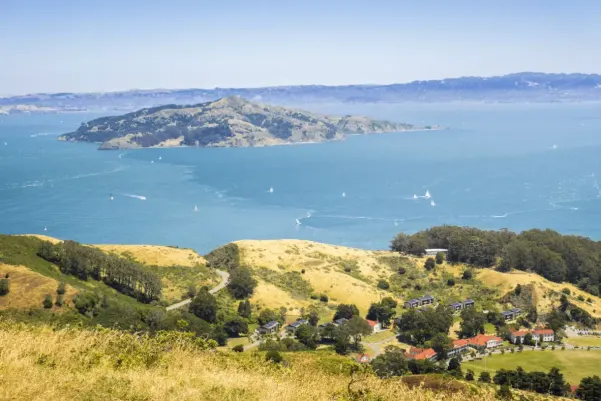Angel Island

Angel Island is the largest island in the San Francisco Bay and filled with history. In 1775, Lt. Juan Manuel de Ayala sailed into San Francisco Bay on a mission to chart the area for future Spanish ships, and anchored his boat next to what he christened Isla de Los Angeles, now known as Angel Island. In the early 19th century, Angel Island had few inhabitants-- a storehouse was built on the island by Russians hunting sea otters off the coast of San Francisco, and a British war ship used Angel Island as a repair station. After 1846 and the war with Mexico, a quarry was developed on Angel Island which provided sandstone for San Francisco’s original Bank of California. During the Civil War, Angel Island became a military post to protect the San Francisco Bay from Confederate attack. The federal government established Camp Reynolds and several artillery batteries on Angel Island. Many of the wooden military buildings from 1863 are still standing on Angel Island, and two are open to the public on docent-led tours.
After the war was over, Camp Reynolds remained on Angel Island, serving as an infantry camp for over 200 soldiers. In 1892, a Quarantine Station was opened at Ayala Cove on Angel Island. Ships from foreign ports coming into the San Francisco Bay were fumigated here and immigrants suspected of carrying infectious diseases like smallpox were held in isolation. An Immigration Station was completed in 1910, amid public controversy, and Angel Island became billed as the “Ellis Island of the West.” However, the Immigration Station on Angel Island was primarily used as a detention facility, due to the Chinese Exclusion Act of 1882, which barred Chinese immigrants from entering the country. In 1970, Angel Island’s Immigration Station was saved from the wrecking ball and has now become a museum showcasing the lives of the thousands of people who were detained here.
The military used Angel Island as a staging area for troops in both World War I and World War II—more than 300,000 soldiers were shipped out to fight in the Pacific through Angel Island until the war ended in 1945. As part of a growing defense system, a Nike anti-aircraft missile was placed on Angel Island in 1954, but was later removed in 1962. Today, Angel Island is a 740-acre State Park, with 13 miles of hiking trails, eight miles of paved biking trails and many basic campsites. Visitors can climb Mt. Livermore for panoramic views of the San Francisco, Mt. Tamalpais, Sausalito, and Oakland. Often called the “Jewel of the Bay,” Angel Island can clearly be seen from the Golden Gate Bridge, the San Francisco Oakland Bay Bridge, Coit Tower and Pier 39, and can be reached by ferries from Oakland, San Francisco, and Tiburon.